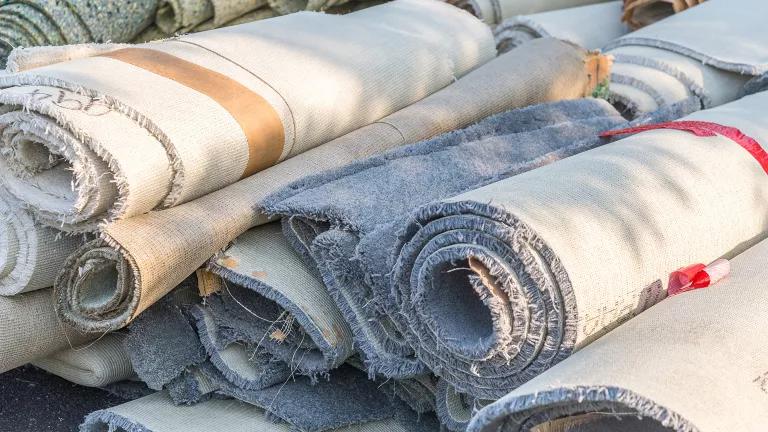Calling New York to Break Up with Toxic PFAS this Earth Day
New York Legislature has a real opportunity to address upstream sources of PFAS contamination.
.jpg.jpg?h=19ad3fdd&itok=mtlQfuNU)
April is Earth month (in honor of Earth Day on April 22nd), and it seems like an April Fool’s joke that National Teflon Day is also commemorated in April to honor the accidental invention of a chemical called polytetrafluoroethylene, or TeflonTM, by Dr. Roy Plunkett in 1938. Since then, chemical companies have invented thousands of chemicals in the same class of toxic chemicals—per- and polyfluoroalkyl substances (PFAS)—and companies like DuPont and 3M have made billions of dollars manufacturing these chemicals while intentionally covering up evidence of their harmful human health and environmental impacts.
So, while National Teflon Day deserves little attention, it is a valuable opportunity to shine a spotlight on the ubiquitous nature of these toxic chemicals. It is estimated that 98% of people living in the US have PFAS in their blood. This is incredibly troubling given the robust scientific literature linking PFAS to myriad health effects—ranging from cancers, hormone disruption and liver dysfunction to birth defects, infertility and immunosuppression.
Environmental advocates, impacted communities, pediatricians, and water utilities in New York are calling for the adoption of legislation to stop the unfettered use and production of PFAS to protect public health. While New York missed an opportunity during the last legislative session to ban PFAS in household products, cosmetics and menstrual products (I’ve written about that here, too), there is a real opportunity to fix that this session and get back on track with leading state action on banning PFAS chemicals.
PFAS downstream is a result of PFAS production and use upstream
About 50% of New York’s public water systems have detected some level of PFAS contamination, and about 250 public water systems have exceeded the state’s PFOA and PFOS drinking water standards or maximum contaminant levels (MCLs). Long Island is particularly impacted and approximately 2 million New Yorkers who receive drinking water through private wells are still in the dark of what is in their drinking water. However, with EPA’s more stringent drinking water standards released this month, the number of water systems in New York with dangerous levels of PFAS is expected to double. The New York State Health Department estimates that 548 public water systems will now exceed the federal MCLs, requiring over a billion dollars in investment and millions in operating and maintenance costs to fit public water systems with the necessary treatment infrastructure.
But where does all this PFAS in the drinking water come from? It comes from upstream sources through every stage of the PFAS production, use, and disposal life cycle—for example, industrial discharges into surface or waste water systems; industrial air emissions that deposit PFAS into water and soils; landfill disposal or incineration of PFAS laden products; contaminated landfill leachate that seeps into groundwaters; spreading of contaminated sewage sludge on agricultural lands; and run-off of firefighting foam. The continued use of PFAS in industrial and product manufacturing only frustrates any real progress in addressing contaminated drinking water. And once these substances enter our environment, they are extremely difficult to contain, clean up, and pose real challenges on how to dispose of the chemicals once they are captured.
What is more, PFAS exposure via drinking water is only the tip of the iceberg as people are exposed to PFAS everyday through food, air, and common household products. Learn more here.

How toxic PFAS chemicals enter the environment and how humans are exposed
Dr. Linda Birnbaum
New York must act on turning off the tap to PFAS now
New York must get serious about limiting further PFAS contamination—starting with stopping non-essential uses of PFAS upstream. Non-essential uses are when PFAS are used but not critical for the product functioning or when there are safer alternatives that exist. The idea of the essential-use approach is not to ban products, but to phase out all non-essential uses of chemicals of concern, such as PFAS. This is all the more important now that the EPA finalized first-ever federal limits on PFAS in drinking water as mentioned above. The continued use of PFAS upstream in products and manufacturing only perpetuates our contamination of water, air, and soils. Fortunately, New York can eliminate several non-essential uses of PFAS in common household items, cosmetics, and menstrual products if the legislature acts now.
A.3556C / S.5648C sponsored by Assemblymember Zebrowski and Senator Hoylman-Sigal bans PFAS in a range of products known to contain PFAS (i.e., textiles, rugs, dental floss, non-stick cookware, ski waxes, household paint, children’s products, cleaning products, and anti-fogging sprays and wipes). The good news is there are already safer, cost-effective alternatives available and other states have already started to ban PFAS in these product categories. For example, many cookware companies have already started to phase out PFAS and reformulated with alternative materials that are safe and provide the same functionality. The same is true for dental floss, paint, cleaning products, textiles, rugs, ski waxes, and children's products, but consumers shouldn’t have to do this level of research to figure out what contains PFAS and what does not!
PFAS and other toxic ingredients are also found in a wide variety of personal care and cosmetic products—cue waterproof mascara. A.6969 / S.4265 sponsored by Assemblymember Glick and Senator Webb puts an end to toxic PFAS and other chemicals in these products. New Yorkers use personal care and cosmetics every day that may contain chemicals linked to asthma, allergies, hormone disruption, neurodevelopmental problems, infertility, and cancer. Women of color are disproportionately impacted by toxic chemicals in personal care products because products marketed to people of color have been found to contain higher amounts of toxic chemicals, such as hair straightening products and skin lighting creams.
Lastly, PFAS and other toxic chemicals (i.e. mercury, and formaldehyde) are unnecessarily present in feminine hygiene products (pads, tampons, liners, period underwear etc.). Chemicals that are known carcinogens and endocrine disruptors, linked to fertility challenges, have no place in products used in and around highly vascular and sensitive areas of the body and should be phased-out immediately. Dermal exposure is often higher than in other parts of the body, making the presence of PFAS in feminine hygiene products of great concern. A.5990 / S.3529 sponsored by Assemblymember Rosenthal and Senator Fernandez bans these chemicals in these products and is a non-brainer bill to pass this earth day.
The regular use of these consumer and household products, along with potential ingestion of PFAS through water and food puts New Yorkers at risk everyday. Passage of these bills is crucial to protect New York communities and the planet.
Eventually, to adequately address the severity of the issue in New York and beyond, we will need to go further and ban all non-essential uses of PFAS (like Minnesota and proposed in California), regulate PFAS in air emissions, prohibit the use of PFAS-laden sewage sludge, and address PFAS in landfill leachate.
How New Yorkers can take action
Contact your New York State Assemblymember and Senator today before the legislative session ends in early June. Let them know that PFAS does not belong in any of these products, and that we need New York to take the lead in protecting communities. Learn more about the steps you can take to avoid PFAS in food, clothes, and home.
This blog provides general information, not legal advice. If you need legal help, please consult a lawyer in your state.
NRDC does not endorse any brands mentioned in any of the links provided above.

.jpg.jpg?h=44b879e5&itok=Mrg2EnX5)

